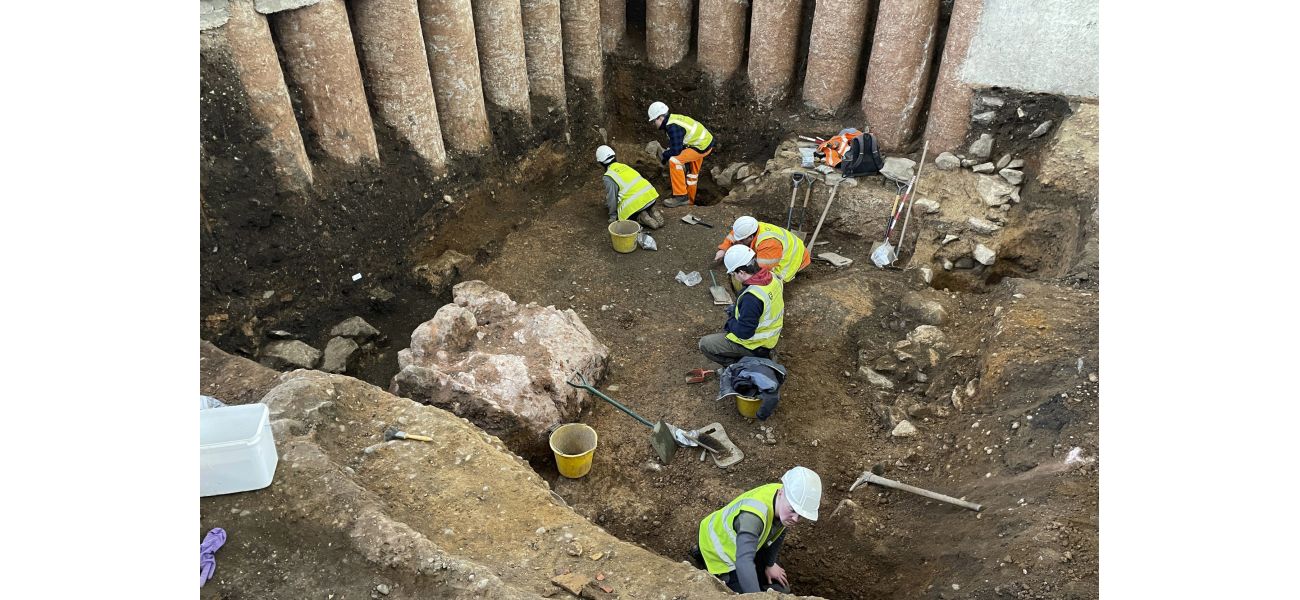More than 100 bodies found in a burial pit, the mysterious circumstances remain unsolved.
No evidence of physical harm found in bones, leaving only two possible explanations for the deaths.
November 17th 2024.

During an excavation at Leicester Cathedral, archaeologists made an intriguing discovery - a vertical shaft containing a staggering 123 bodies. However, the circumstances surrounding their deaths remain a mystery. The remains, believed to belong to men, women, and children from the early 12th century, were found just a few meters away from the cathedral's gardens. According to the Guardian, this is one of the largest pit burials ever found in the UK.
The cause of death for these individuals is still unknown, as there are no signs of violence on their bones. Project officer Mathew Morris from Leicester University's archaeological services explains, "This leaves us with two possible explanations - starvation or pestilence. Currently, our main hypothesis is that it was a result of a pestilence outbreak." The excavation also revealed that the bodies were placed in the shaft in three separate deposits, one after another in a short period of time, suggesting that they were brought there in quick succession.
It is estimated that these 123 bodies accounted for about 5% of the town's population during that time. While pit burials have been previously found in the region, this one is the largest, and the team has not been able to find any others in the country that are comparable. "Pestilences, fevers, hunger, and famine were common during the mid-10th to mid-12th century, as mentioned in the Anglo-Saxon Chronicles," explains Morris. "This burial fits within that timeframe and provides physical evidence of what was happening across the country during that period."
Initially, the team suspected that the individuals were victims of the Black Death, but radiocarbon testing on the bones showed that they lived about 150 years before the disease reached England in 1348. In an effort to uncover the true cause of death, geneticists at the Francis Crick Institute in London will analyze samples from the bodies to search for any viruses, bacteria, or parasites.
The excavation at Leicester Cathedral began in 2021 and has now been completed. It was part of a larger archaeological survey of the cathedral grounds, as plans were approved to build a new heritage learning center there. With the discovery of King Richard III's remains under a nearby car park 12 years ago and his subsequent reburial at the cathedral, there has been a significant increase in visitors. The hope is that the new center will help the cathedral manage this influx of visitors.
In addition to the pit burials, the archaeological team also uncovered the remains of 1,237 individuals buried in the gardens, dating back to the early 11th century until the 19th century. "It's a continuous sequence of burials spanning 850 years and from a single population in one location. This is a rare find," says Morris. The excavation also revealed other interesting findings, such as Anglo-Saxon dwellings and a Roman shrine, providing a glimpse into the history of this area.
The cause of death for these individuals is still unknown, as there are no signs of violence on their bones. Project officer Mathew Morris from Leicester University's archaeological services explains, "This leaves us with two possible explanations - starvation or pestilence. Currently, our main hypothesis is that it was a result of a pestilence outbreak." The excavation also revealed that the bodies were placed in the shaft in three separate deposits, one after another in a short period of time, suggesting that they were brought there in quick succession.
It is estimated that these 123 bodies accounted for about 5% of the town's population during that time. While pit burials have been previously found in the region, this one is the largest, and the team has not been able to find any others in the country that are comparable. "Pestilences, fevers, hunger, and famine were common during the mid-10th to mid-12th century, as mentioned in the Anglo-Saxon Chronicles," explains Morris. "This burial fits within that timeframe and provides physical evidence of what was happening across the country during that period."
Initially, the team suspected that the individuals were victims of the Black Death, but radiocarbon testing on the bones showed that they lived about 150 years before the disease reached England in 1348. In an effort to uncover the true cause of death, geneticists at the Francis Crick Institute in London will analyze samples from the bodies to search for any viruses, bacteria, or parasites.
The excavation at Leicester Cathedral began in 2021 and has now been completed. It was part of a larger archaeological survey of the cathedral grounds, as plans were approved to build a new heritage learning center there. With the discovery of King Richard III's remains under a nearby car park 12 years ago and his subsequent reburial at the cathedral, there has been a significant increase in visitors. The hope is that the new center will help the cathedral manage this influx of visitors.
In addition to the pit burials, the archaeological team also uncovered the remains of 1,237 individuals buried in the gardens, dating back to the early 11th century until the 19th century. "It's a continuous sequence of burials spanning 850 years and from a single population in one location. This is a rare find," says Morris. The excavation also revealed other interesting findings, such as Anglo-Saxon dwellings and a Roman shrine, providing a glimpse into the history of this area.
[This article has been trending online recently and has been generated with AI. Your feed is customized.]
[Generative AI is experimental.]
0
0
Submit Comment





